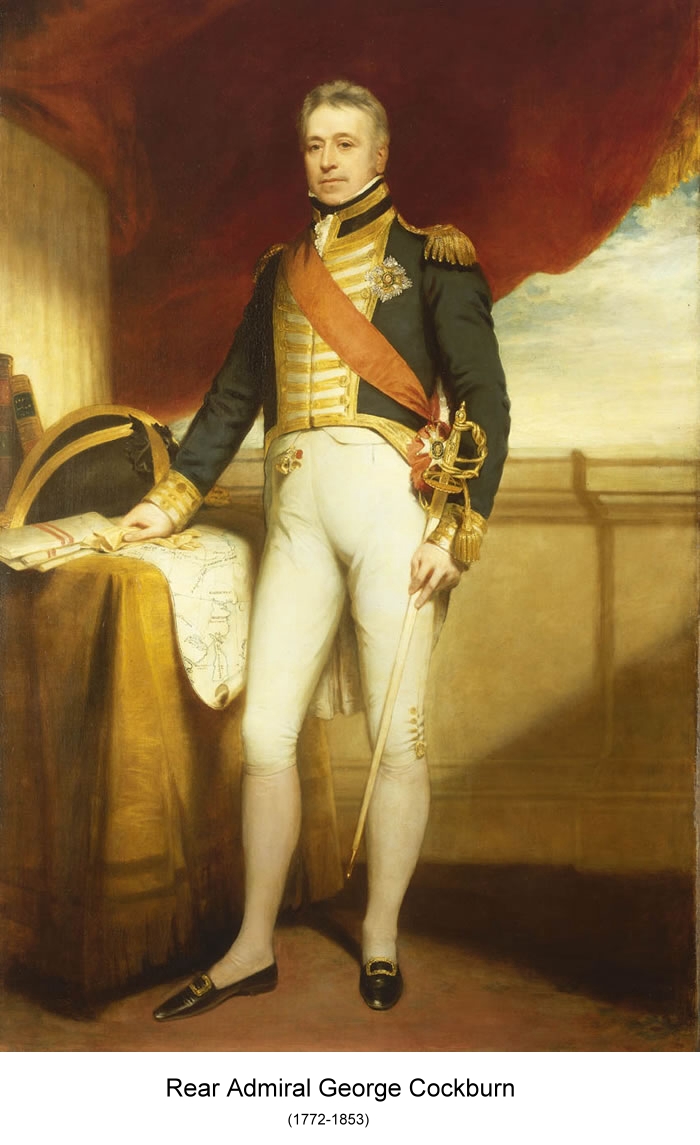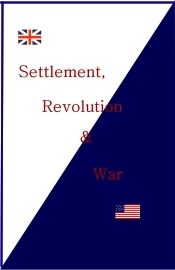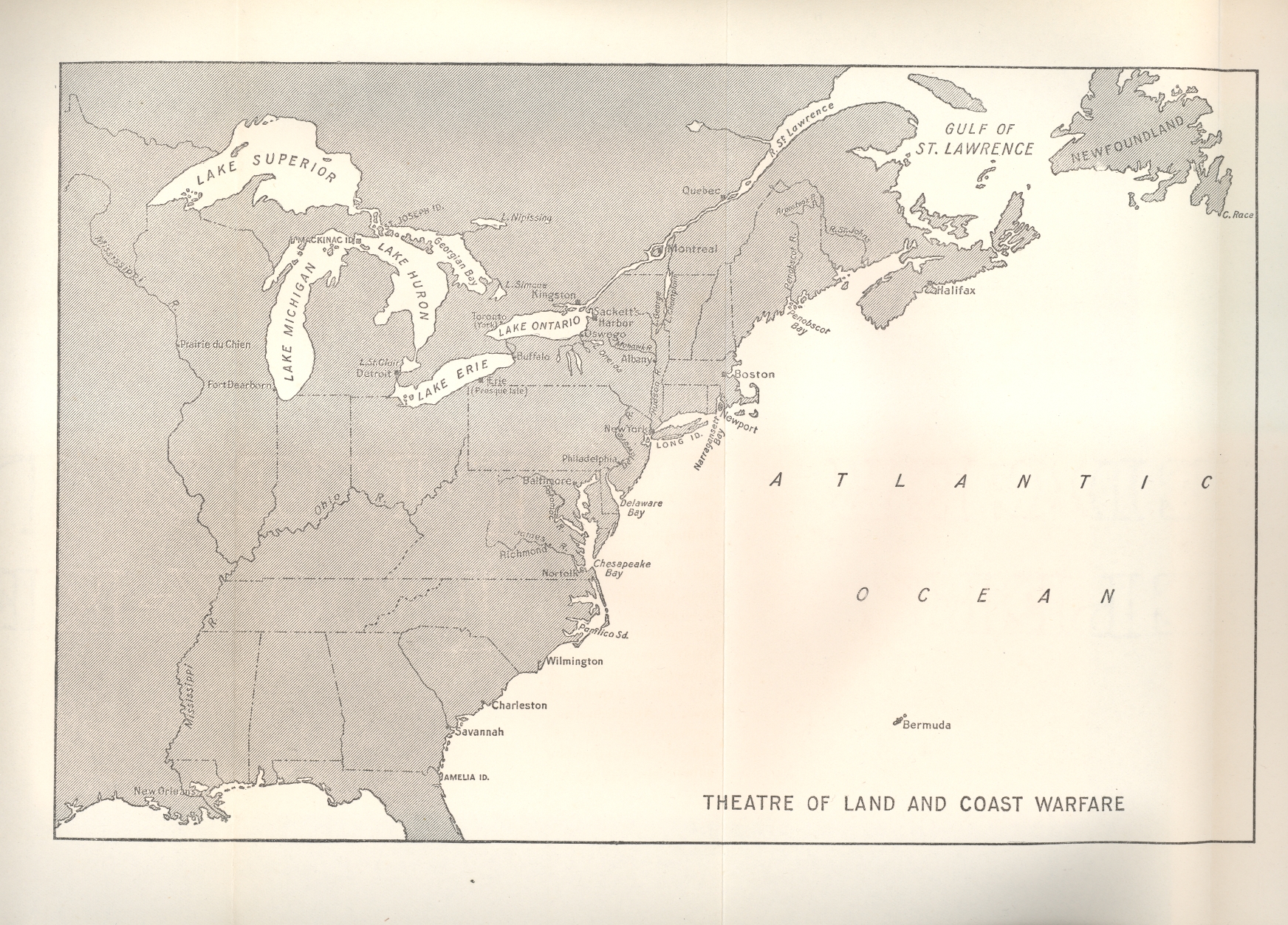
 Book #2: Settlement, Revolution & War.
Book #2: Settlement, Revolution & War.
In Europe, the long 23-year war with Napoleonic France was winding down. The allies crossed the Rhine and invaded France in the early months of 1814. During April, Paris was captured, Bonaparte abdicated and a convention was entered into for the cessation of hostilities. Before the year was out, the hostilities between the British and the Americans also ended. A state of war had existed from June, 1812 to December, 1814. The British during the war with the Americans had little concern about a possible American land attack against Nova Scotia. The concern throughout was for Upper Canada. In 1813, during the coldest part of the year, the 104th Regiment of Foot (The New Brunswick Regiment) traveled overland up the frozen Saint John River in order to reenforce the Upper Canadian borders. On April 4th, 1813, in a letter to Bathurst, Sherbrooke reported that he has "made arrangements to bring the remainder of the 98th Reg't to Halifax, from which port they will depart for Canada as soon as the 64th shall arrive at Bermuda."1
In May of 1813, the "garrison of Halifax consisted of six companies of the 98th foot, four companies of the 99th foot, and a detachment of artillery. At Annapolis, there were two companies of the 99th."2 On the first of June, transports under the protection of the Royal Navy came in from the West Indies, bringing in the 13th and 64th regiments. The 13th went to Quebec, while the 64th remained at Halifax.3 Men of the British Navy were ever-present at Halifax. It was the principal naval dockyard for the British in North America for a good number of years. In the spring of 1813, we see where "Sir J. L. Yeo, with 450 seamen, arrived at Quebec. They were intended for service on the lakes. Meantime, Sir John C. Sherbrooke had shipped cannon, &c., for two sloops of war, to be employed on the Canada lakes -- $120,000 in specie, and a company of Royal artillery; also a detachment of the 104th regiment, -- all for service of Canada."4 Under Lieut. Henry Kent, 210 volunteer seamen from the British naval ships then in Halifax left by sea for Saint John, New Brunswick on January 21st, 1814. From there, using sleighs, they traveled up the frozen Saint John River, at the top of which, they exchanged the sleighs for toboggans and snow-shoes and headed overland to Quebec. After that, they continued on to Kingston, which they reached on March 22nd. The object was to build an inland British navy.5 As it happened, The War of 1812 revealed itself dramatically in both land and sea battles in and around the lower Great Lakes.
I have, in previous chapters, reviewed the conflicts at sea between the British and American navies. These were classic, one-on-one, nautical battles between large square-rigged sailing ships bristling with smooth-bored cannon. While British naval captains would never normally back down from a fight, they were directed not to seek such fights. Their job, for the duration of the war, was to be "Commerce Raiders." This was made clear, at the very start.
"On May 9th, 1812, identical instructions were issued to each of the admirals commanding the four transatlantic stations, -- Newfoundland, Halifax, Jamaica, and Barbados, -- warning them of imminent probability of hostilities, in the event of which, by aggressive action or formal declarations on the part of the United States, they were authorized to resort at once to all customary procedures of war; 'to attack, take or sink, burn or destroy, all ships or vessels belonging to the United States or to the citizens.'"6
|
So it was the lot of the British ships of war was "to attack, take or sink, burn or destroy, all ships or vessels belonging to the United States or to the citizens." To carry out these instructions, the British naval ships generally sailed in a squadron and often in co-operation with licensed, British privateers. They took prizes, of course, and this was as good an objective as any for the officers and crews of both British naval vessels and British privateers. The objective of the British war department, however, was to cause economic ruin to the communities of the American eastern seaboard. In season, it was only those motivated by large profits who would run the British blockade. I write "blockade," but that may be a misuse of the term as the American coast was much too long to be patrolled continuously throughout the year as were the waters off the ports of France. In America, it could only be done in season and not at all for most of the long eastern seaboard that extended from Maine to Georgia. Not all of the major American ports were easy to watch. Certainly Boston was. New York was different for it was difficult to gather in a British net on account of the wide entrances of Long Island Sound. Comparatively, the entrance to the Chesapeake Bay and that of the Delaware, was less difficult to watch than that of New York. If the entrance to a Bay or a Harbour was narrow enough, then defensive cannon could be placed on shore, keeping the British at sea. The Chesapeake and Delaware are wide-mouthed estuaries, and, as such, were open doors through which the British could come for easy pickings. It was on account of this, that the communities surrounding the Chesapeake Bay and the Delaware Bay were to bear "the full brunt of hostile occupation and widespread harassment." This was especially so of the Chesapeake which was not so much blockaded as it was occupied. Or, as the eminent American naval historian, Alfred T. Mahan pointed out, the Chesapeake was blockaded from within. During the War of 1812, Chesapeake Bay was the principal scene of active operation by the British navy.7
During the war years, 1812-14, Admiral, Sir John Borlase Warren was put in charge of all transatlantic Stations: Jamaica, the Leeward Islands and Halifax.8 Warren was familiar with the territory, as he was the Commander-in-Chief of the North American and West Indian Stations during the years 1807-1810. In taking up his position in 1812, Warren was supplied with "upwards of ten of the line, exclusive of the six sail of the line appropriated to the protection of the West India convoys."9 He acquainted the Admiralty with the great distances of the Atlantic seaboard and made the case that if he were to exert any meaningful pressure he would need substantial reinforcements. Thus, Rear Admiral George Cockburn (1772–1853) was ordered at the end of 1812 from the Cadiz station, with four ships of the line and several smaller cruisers.10 During the winter, early 1813, Cockburn with his fleet and re-enforcements from Europe joined Warren at Bermuda.
 By 1813, there was, under Warren and Cockburn, a large and heavily armed British fleet. They usually had aboard battalions of marines in addition to the large crews of these sailing vessels. Up to this point there had been no "commercial blockade" of the United States. By March, however, the admirals and their combined fleets were operational in the Chesapeake.11 I quote Mahan:
By 1813, there was, under Warren and Cockburn, a large and heavily armed British fleet. They usually had aboard battalions of marines in addition to the large crews of these sailing vessels. Up to this point there had been no "commercial blockade" of the United States. By March, however, the admirals and their combined fleets were operational in the Chesapeake.11 I quote Mahan:
"The fleet, comprising several ships of the line, besides numerous smaller vessels, continued slowly upwards, taking time to land parties in many quarters, keeping the country in perpetual alarm. The multiplicity and diverseness of its operations, the particular object of which could at no moment be foreseen, made it impossible to combine resistance. The harassment was necessarily extreme, and the sustained suspense wearing; for, with reports continually arriving, now from one shore and now from the other, each neighborhood thought itself the next to be attacked. Defence depended wholly upon militia, hastily assembled, with whom local considerations are necessarily predominant. But while thus spreading consternation on either side, diverting attention from his main objective, the purpose of the British admiral was clear to his own mind. It was 'to cut off the public works, by penetrating the rivers at the head of the Chesapeake.'"12
The operations of the British navy in the Chesapeake for the year 1813, given that it had complete control of its waters, were disappointing to the British administration. Warren, it would appear, kept an eye on the main entryway to the Chesapeake while Cockburn launched land attacks in the northwestern end. Cockburn's force went first up the Elk River. A landing was effected at Frenchtown on April 29th. It was there that a "quantity of flour and army equipment were destroyed, together with five bay schooners. Many cattle were likewise seized ..."13. From Frenchtown, Cockburn took his ships and men to the Susquehanna. There he got into a bit of a fight with the Americans. "A nominal resistance was made, but as the British loss, here and at Frenchtown, was one wounded on each occasion, no great cause for pride was left with the defenders."14 Cockburn expected a much greater resistance to the British incursions. He wrote Warren: "Our small division has been during the whole of this day on shore, in the centre of the enemy's country, and on his high road between Baltimore and Philadelphia." From the Susquehanna, Cockburn then went to the Sassafras River. There the British were offered some resistance with the consequences being that two villages, Georgetown and Frederickstown, were destroyed. Cockburn being satisfied that "public property, vessels, nor warlike stores" remained in the territory, his expedition return down the bay on May 7th and regained the main fleet. Warren then took a large portion of his fleet to Bermuda to pick up a division of soldiers (about twenty-six hundred) that had been transported from England. Warren's plans were to capture Norfolk and the 36-gun American frigate, the Constellation which was then lying there.15 Warren's attempts to capture Norfolk failed.16 And, for the balance of the season, the British forces did not accomplish much beyond what Cockburn had achieved in the early part of the season; no major centres on land were seriously threatened during 1813.
The British were disappointed with their operations in the Chesapeake for 1813. They did however achieve a result which was not immediately observable, at least to themselves. They had effectively frozen the commerce of the young United States up and down the eastern seaboard. The Columbian Centinel reported in the fall of 1813, that "Our coasts unnavigable to ourselves, though free to the enemy and the money making neutral; our harbors blockaded; our shipping destroyed or rotting at the docks; silence and stillness in our cities; the grass growing upon the public wharves."17
[NEXT: Pt. 5, Ch. 14 - "The Burning of Washington."]

